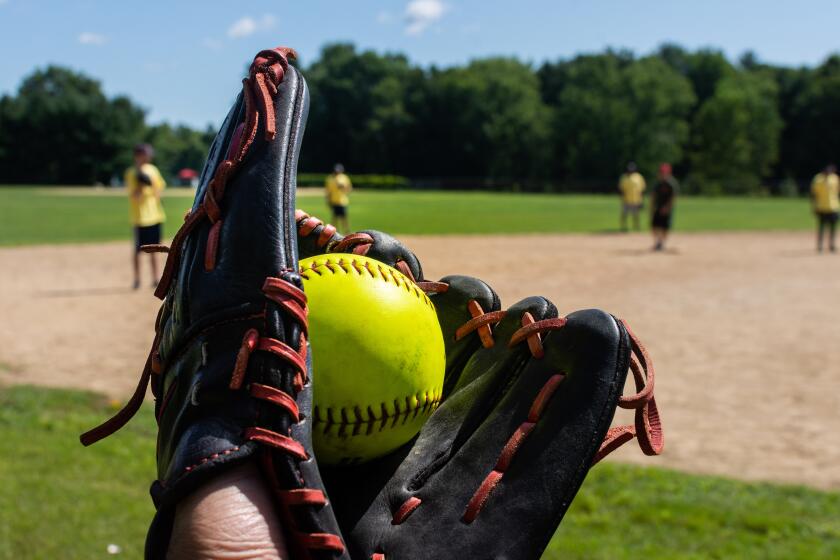Shelling Out Advice
- Share via
The king of peanut-bag pitchers tossed some valuable advice Wednesday to teenagers.
Stay in school, Dodger Stadium vendor Roger Owens warned 10th-graders in Marina del Rey. Or else you’ll really be working for peanuts the rest of your life.
Owens, famed for his behind-the-back delivery that can send a two-bagger sailing 10 rows or more, starts his 39th season with the Dodgers on Monday.
“This is part of my spring training,” he told 10th-graders at Westside Alternative School as he peppered them with bags fired over his shoulder and between his legs.
“I don’t want to come down with peanut elbow, you know.”
Goobers have been very, very good to him, acknowledged Owens, 53, of Torrance. But not good enough to convince him to give up his day job.
Two-thirds of his income is from work as a sales representative for a trucking firm, he revealed. Baseball stadium peanut vendors only earn 31 1/2 cents per two-bagger--from $150 to $200 a night.
“I’m the only major league pitcher who made less than $1 million last year,” he said with a laugh.
*
But his peanut prowess has landed him in Sports Illustrated--and on the “Tonight Show” four times. And it has taken him to six Japanese baseball championship playoffs as well as to countless sports events in this country.
His celebrity is such that Westside teacher Marisa Miller immediately recognized Owens a few weeks ago at a Starbucks coffee outlet in Santa Monica and invited him to talk to her sophomore career-planning class.
Owens told the students that the baseball stadium has taught him plenty about the importance of learning to communicate with people and capitalize on opportunities.
He was their age in 1958 when he started out pouring soft drinks from bottles into cups for fans packing the Los Angeles Coliseum after the Dodgers moved here from Brooklyn, Owens said.
“I grew up in Central Los Angeles, went to Manual Arts High School. I was the oldest of nine children, and we were struggling to get by. My brothers and sisters and I all had to help out. My job was to sell sodas at the Coliseum.”
He hustled up and down aisles, watching the crowd, not the game, earning 3 cents for every cup he sold. “I was promoted from 7-Up to Coke and then to ice cream,” he said. He graduated to goobers by the Dodgers’ third home stand.
In 1959, after what he calls his “rookie season,” Owens started perfecting his peanut pitch.
But trying to work your way up to Dodger Stadium’s peanut gallery isn’t that easy these days, Owens cautioned. Vendors now face 17 years of selling soft drinks, frozen treats and cotton candy before graduating to a peanut position.
“Baseball was different back when I started. There was a lot less stress in the world,” he said. “These are the ‘90s--go to college, or you’ll be left in the dust. Don’t drop out. You’ll feel better about yourself.”
*
Although he attended Compton College, Owens explained that his real education came when he majored “in peanuts at the University of Nuts and Bolts.” His comments were salted, in fact, with peanut humor.
Why do you never find peanuts pitching in the major leagues? “Because they’re afraid they’ll get shelled . . . or cracked under the pressure,” he said. And what about those two bags of peanuts that the police found on the New York subway? “One was a salted,” he said.
Students had plenty of nuts-and-bolts questions for Owens too.
Fifteen-year-old Jasmine Desenclos wanted to know how he remembers which peanut-catchers to collect money from as he rapidly works the stadium crowd. “I have a memory like an elephant,” he answered.
Kuva Zakheim, also 15, wondered if he has patented his bag-tossing technique. Owens replied that he hasn’t had to because no one else has yet to duplicate his wrist-flicking style.
“I’ll do it like this when I’m 75 and the arm is bad,” Owens added, slam-dunking a bag into the open palms of 15-year-old Khalid Farris.
Owens is that kind of nut.
More to Read
Go beyond the scoreboard
Get the latest on L.A.'s teams in the daily Sports Report newsletter.
You may occasionally receive promotional content from the Los Angeles Times.











